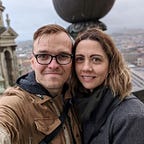Revolutionizing the global supply chain with Chorus
Each year Gartner releases its Supply Chain Top 25 to highlight leaders in planning, sourcing, manufacturing, and logistics. While not the most talked-about list, the companies that join its ranks tend to dominate their respective industries.
Apple has topped the list for so many years they’ve joined Unilever, Amazon, P&G and McDonalds as Supply Chain Masters, an honor that reflects their ability to weather hectic market conditions.
Matching Apple’s supply chain prowess might seem like a pipe dream, but in 2021 we worked with a client whose product might actually level the playing field, or at least help less established companies achieve similarly superb supply chain visibility.
Chorus came to us with an abstract idea for an artificial intelligence system that would enable organizations to spot wasteful gaps in their pipelines. The client needed us to flesh out the product definition and provide a robust roadmap detailing a phased approach to a costly business problem.
“Something like two percent of the world’s raw materials are unaccounted for,” says O/M lead product designer, Ted Schaller. ”When you’re talking trillions of dollars worth of goods, that’s an incredible amount of money.”
Consider the life of a single IV pump. Its raw materials are sourced from all over the world, transported to different fabrication centers in various places, turned into tubing, casing and electronic components, shipped to different areas, transported on different vehicles to a factory that takes those pieces to create the IV pump which is then delivered first to regional warehouses, then to statewide warehouses before finally landing in various hospital systems and private clinics. It’s not hard to imagine the chances of something slipping through the cracks at any one of these transitions.
With Chorus, all pumps could be tracked not just as final products but as every single component that makes them viable. For the initial live testing of Chorus, the company focused on helping Japan effectively distribute and reallocate Covid vaccines at the height of the pandemic. Given the stakes, it was absolutely critical to exercise utmost quality control. Even the slightest misstep could greatly impact public health.
The underlying software behind Chorus is an AI system that’s able to map out the intricacies of a product’s journey, packaged in technology that’s about a quarter of the size of an Apple air tag.
Of course, the thought of slapping a sticker on anything — or anyone, without their consent — brings up major ethical concerns. We discussed ethical AI best practices with Chorus, who entered the conversation with a strong sense of their responsibility to bake in guardrails against misuse. We brought our past expertise working with AI based products and Inclusive Design principles to help guide the team during the design process.
We’re learning on a daily basis how we, as designers, can advance the best possible outcomes of every AI project we take on. Inclusive design necessarily involves the impact of advanced technology on humanity. Every client relationship involves a good deal of trust, and we believed enough in Chorus to help them secure their second round of funding.
Our process included rapid iterations of lightweight interface designs and abstract concepts to illuminate the technology’s potential — and prove value to investors.
We interviewed industry leaders and customers throughout the process to validate our recommendations. These insights helped us make structural changes to their current system and outline how Chorus could tackle first-, second- and third-order problems.
First order challenges can be tackled in the immediate future, like giving visibility into asset location, missing assets, asset condition, temperature tracking, and providing the inability to intervene when loss occurs — or at least adjust for it in the future.
Second order problems addresses system-wide inefficiencies to better orchestrate a supply chain across multiple companies.
“The ability to see end-to-end gives smaller companies a better sense of verticalization like Apple has,” says Schaller.
Finally, the third order involves systemic change. How could Chorus help inform systemic change; how could it inspire and support new companies and industries?
“These are global impact changes well outside the scope of what Chorus is trying to do, but shows what the Chorus technology unlocks,” says Schaller.
Final deliverables included UX/UI to communicate how Chorus could be built as well as projected scenarios exploring the type of insights the product could collect in 5–10 years, the type of visibility it would have, and what kind of data integrations they could support down the road.
Proof of concept is absolutely critical in unstable and uncertain economic times. Especially when it comes to emerging and unproven technologies. At O/M, we welcome the opportunity to partner with and guide new clients from initial product offering to successful acquisition, supported by accessible, inclusive, and responsible design.
To learn more about OM or to inquire about our design services, contact us at hello@omstudio.co
